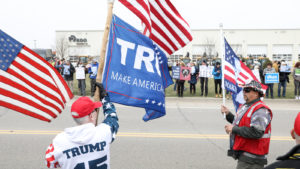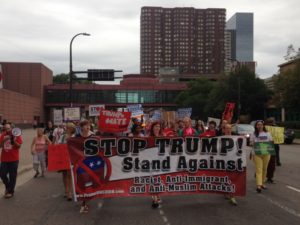This article contains news and liberal commentary.
Minnesota could be a metaphor for the entire election.
Trump is chasing Minnesota’s 10 electoral votes because, “If Trump can flip Minnesota, he could lose Michigan, Wisconsin and Pennsylvania to Joe Biden and still get re-elected if he holds the rest of his 2016 victories,” NBC News says. Read story here.
That’s still a big “if” because it requires holding several states where he’s in trouble — Florida, Ohio, North Carolina, Arizona — and even with those states he also needs to keep 1 electoral vote each in Maine and Nebraska just to reach 270 electoral votes, with none to spare.
Anyone who thinks about it will realize he badly needs an additional state for a safety margin, in case he loses one of those votes, but the difficulty of getting one illustrates how desperate his situation is in any honest, straightforward election whose outcome doesn’t depend on disinformation campaigns, voter suppression, interrupting mail delivery, legal challenges, and possibly outright thuggery at the polls.
 In Minnesota, as nationally, Trump is basing his tactics on winning the less-populous small towns and rural areas. In Minnesota, he’s concentrating on the Iron Range, where mining employment has fallen by three-fourths since the 1970s, much of that due to automation, which means neither he nor anyone else can bring back those jobs. People there ought to be more concerned about the social safety net he’s trying to shred, because they’re going to need it, but politics isn’t rational.
In Minnesota, as nationally, Trump is basing his tactics on winning the less-populous small towns and rural areas. In Minnesota, he’s concentrating on the Iron Range, where mining employment has fallen by three-fourths since the 1970s, much of that due to automation, which means neither he nor anyone else can bring back those jobs. People there ought to be more concerned about the social safety net he’s trying to shred, because they’re going to need it, but politics isn’t rational.
There’s no denying that flipping blue-collar workers red was a political earthquake. For several decades, these workers were the backbone of Democratic New Deal and post-New Deal coalitions. They began drifting away in the 1960s in reaction to antiwar protests. The end of unions, outsourcing of factory jobs, and hollowing out of the middle class accelerated the process, and the GOP’s culture wars amplified it. In 2016 many of these voters, disenchanted with Democrats and seeking a savior, turned to Trump and they may now be an irretrievable part of the Republican coalition.
 But playing to this constituency is in many ways playing before half-empty bleachers. The numbers simply aren’t there to keep a national party in power. And the GOP’s gains among rank-and-file workers has been offset by the loss of its formerly formidable advantage among educated and well-off voters concentrated in America’ suburbs, whom Trump has spurned and his followers disdain.
But playing to this constituency is in many ways playing before half-empty bleachers. The numbers simply aren’t there to keep a national party in power. And the GOP’s gains among rank-and-file workers has been offset by the loss of its formerly formidable advantage among educated and well-off voters concentrated in America’ suburbs, whom Trump has spurned and his followers disdain.
Demographic trends, too, are against such a strategy. Small towns and rural areas, where Republicans are concentrated, are losing the population race to urban areas, where Democrats are concentrated. Over the last decade, the Minneapolis urban area has grown 3 times more than the rest of the state.
In Minnesota, as elsewhere, resentment is palpable in the hinterlands. The NBC News article quotes a Minnesota political scientist as saying, “There’s a lot of resentment out there in the Iron Range,” because people there see “their influence in the state as slipping.”
“‘They’re pandering to big cities,’ said Jim Nelson, 37, a union nurse from outside Duluth, referring to Democrats. He supported Trump in 2016 and plans to vote for him again,”
the NBC article says. I see the same attitude in Washington, where I live. Rural eastern Washington, with a mostly agricultural economy, has two-thirds of the state’s land area (and most of its hunting and fishing), but only a fifth of its population. It’s not reasonable for a demographic constituting such a small slice of a state’s population to think they have some kind of natural right to run things, in derogation of the voting rights of city people, but that’s the mentality.
 Minnesota’s Iron Range mines employ 4,000 people in a state of 5.6 million people, and their wants don’t trump everyone else’s. But you can’t tell them that, any more than you can convince the 1,500 residents of an eastern Washington town that Seattle taxpayers are subsidizing their public services (which is a bedrock belief in those places), and not the other way around (which is the reality).
Minnesota’s Iron Range mines employ 4,000 people in a state of 5.6 million people, and their wants don’t trump everyone else’s. But you can’t tell them that, any more than you can convince the 1,500 residents of an eastern Washington town that Seattle taxpayers are subsidizing their public services (which is a bedrock belief in those places), and not the other way around (which is the reality).
In Minnesota, the reality is that Biden leads statewide by +9 points in the most recent poll published on RealClearPolitics on September 13, 2020. But Democrats can’t afford to get complacent about that poll or any other poll; the 2016 outcome drove home the lesson that no swing state can be taken for granted or ignored, and Minnesota is now a swing state.
 But Minnesota looks very uphill for Trump, notwithstanding his Iron Range strategy, or maybe because of it, because that strategy implies writing off the places where majorities of America’s voters live.
But Minnesota looks very uphill for Trump, notwithstanding his Iron Range strategy, or maybe because of it, because that strategy implies writing off the places where majorities of America’s voters live.
Photos: Pro and anti-Trump crowds (above); Trump country (left) and Biden country (right)
I think the importance of the Presidential debates is over done. Still I think a lot will depend on them. I usually like to just listen to the debates…and watch later, and one can come to different conclusions just listening. Biden might be well advised to avoid the debates if his cognitive abilities really have degraded, but if he does it would be acknowledgement that there is an issue. If Biden fails to come across as a competent human being there goes the election.
As it is I think there is a fair chance we could have a Republican governor this election. Sure feel like I am talking crazy, but it could be possible, and maybe Trump picks up Washington a real long shot, still the magic number is 270, and Nixon did really well back in 72, though hardly anyone admitted they voted for him. He got a landslide victory like no other. I know that is just crazy talk.